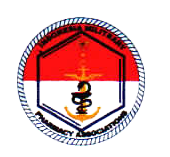Stability Analysis of Mathematical Models of Corrupt Behavior with Death Penalty Sanction
(1) Direktorat Keuangan Angkatan Darat
(2) Politeknik Angkatan Darat
(*) Corresponding Author
Abstract
Keywords
References
Ahmed, M., Kamal, M., & Hossain, M. (2025). A Mathematical Model of Corruption Dynamics and Optimal Control. ScienceDirect, 1 - 11. doi:https://doi.org/10.1016/j.fraope.2025.100216
Amnesty International. (2023). Laporan Global Amnesty International Hukuman Mati dan Eksekusi 2023. Amnesty International. Retrieved from amnesty.org/amnesty.id
Aprilia, R., & Panjaitan, D. J. (2022). Pemodelan Matematika. Medan: LPPM Unmaw.
Australian Government. (2023). DFAT Country Information Report Indonesia. Australia: Australian Government Department of Foreign Affairs and Trade.
Badan Pusat Statistik. (2024, February 19). Posisi Cadangan Devisa (Juta US$), 2023. Retrieved from Badan Pusat Statistik: https://www.bps.go.id/id/statistics-table/2/MTA5MSMy/posisi-cadangan-devisa.html
Cahyani, G. T., Sholehah, S. B., Salsabillah, D. N., Ramadhana, M. A., Pratama, R. A., & Antoni, H. (2023). Analisis Hukuman Mati di Indonesia dalam Perpektif Hak Asasi Manusia dan Alternatif Penegakan Hukum. Al-Qisth Law Review, 7(1), 167 - 184.
Corruption Perceptions Index. (2024). Corruption Perceptions Index 2023. Retrieved from http://www.transparency.org/cpi
Indonesia Corruption Watch. (2024). Laporan Hasil Pemantauan Tren Korupsi Tahun 2023. Jakarta Selatan: Indonesia Corruption Watch.
Kemenkumham. (2019). Undang-Undang Republik Indonesia Nomor 19 Tahun 2019 Tentang Perubahan Kedua Atas Undang-Undang Nomor 30 Tahun 2002 Tentang Komisi Pemberantasan Tindak Pidana Korupsi. Jakarta.
Kementerian Sekretaris Negara. (2023). Undang - Undang Republik Indonesia Nomor 1 Thaun 2023 tentang Kitab Undang - Undang Hukum Pidana. Jakarta.
Munasto, D. (2022). Kebijakan Hukuman Mati Bagi Pelaku Tindak Pidana Korupsi Dikaji dalam Perpektif Sosiologi Hukum. Widya Pranata Hukum, 4(1), 24 - 38.
Nagy, G. (2015). Ordinary Differential Equations. Michigan: Michigan State University.
Nicola, A., & Rohman, Z. (2023). Evaluasi Komisi Pemberantasan Korupsi 2019 - 2023. Transparency International Indonesia.
Syauket, A., & Wijanarko, D. S. (2024). Buku Ajar Tindak Pidana Korupsi. Malang: PT Literasi Nusantara Abadi Group.
Ubaidillah, F. (2020). Persamaan Differensial Biasa. Jember: UPT Percetakan & Penerbitan Universitas Jember.
Widayati, T., Chatra, M., Daengs, A., Nugroho, Rahayu, S., Boari, Y., . . . Suryahani, I. (2023). Perekonomian Indonesia (Perkembangan & Transformasi Perekonomian Indonesia Abad 21 Terkini). Jambi: PT Sonpedia Publishing Indonesia.
Widyawati, D. A. (2016). Solusi Sistem Persamaan Diferensial Linear Tak Homogen Dengan Metode Matriks Eksponensial. 18 - 25.
World Bank Group. (2023). GDP per capita (current US$) - Indonesia. Retrieved from World Bank Group Data: https://data.worldbank.org/indicator/NY.GDP.PCAP.CD?end=2023& locations=ID&start=2013
Yani, M. A. (2022). Corruption Crimes in Indonesia in Criminology Review. Budapest International Research and Critics Institute-Journal (BIRCI-Journal), 26622 - 26632.
DOI: https://doi.org/10.33172/jp.v11i1.19868
INDEXED BY:
Office Address:
Lembaga Penelitian dan Pengabdian Kepada Masyarakat
Republic of Indonesia Defense University
Jl. Salemba Raya No.14, Paseban,Jakarta Pusat, Daerah Khusus Ibukota Jakarta 10440, Indonesia
Email: jurnal.unhan@idu.ac.id

Jurnal Pertahanan: Media Informasi tentang Kajian dan Strategi Pertahanan yang Mengedepankan Identity, Nasionalism dan Integrity is licensed under a Creative Commons Attribution-NonCommercial 4.0 International License.




